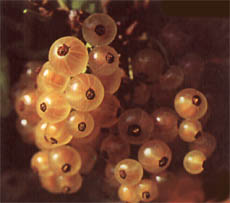Crops
Ribes niveum (Rchb.f.) Stein - White currant, Snow currant
Taxonomy.
Family Grossulariaceae DC., genus Ribes L.Morphology and biology.
2n=16Shrub 1-1.5 m (up to 3 m), with brown smooth shoots (one-year shoots often with scale off bark) and alternate leafs. Leaves are rounded with a toothed margin, with 3 deep blunt laminas and wedge-shaped base, naked. Roots are in upper soil layers (till 60 cm). Buds can be growth, simple, flowering and combined, which give flowers and growth parts. Flowering buds are situated by groups. Flowers are bell-shaped, with double sympetalae perianth, combined in 5-15-flowers raceme 5-7 cm length. Petals are small, yellowish or greenish. Mature berries are spherical, 6-8 mm diameter, naked, white, light-cream-coloured, yellow, polyspermatous. Middle weight of 1 ripe berry is 0.5 g, maximum is 1 g and more. Flowering in May, bear fruit in July. Bearing is concentrated on 3-5 years old shoots (and older). Shrub lives 15-20 years.
Distribution and origin.
Species of North-American origin. In bound of the former USSR it is cultivated in the central regions of European parts and Siberia (Novosibirsk). Cultivated mostly on personal plots.Ecology.
Frost-resisting. Photophilous. Optimal temperature for growth 18-20°C. Exacting to soil. Prefers minimal level of subsoil waters 0.6 m, pH subacid or neutral, light and dry sandy or loamy soils. Self- and cross-pollinated.Economic value.
Berries contain 4-11% sugars, till 3.8% organic acids, mineral salts, tannins, vitamins C and P. Used as fresh berries, and for cooking jelly, fruit drinks, vine. Main sorts: Belaja Potapenko, Bel.ana, Bajana, Belaja feja, Belka, Juterborgskaja (high harvest), Versal.skaja belaja (middle harvest). Juterborgskaja is macrocarpous sort (berries mass from 1,0 g and more), other sorts with berries middle size. Taste qualities of fruits: sour (Versal.skaja belaja), sour-sweet (Belaja Potapenko, Bel;ana, Bajana, Belaja feja), sweet-sour (Belka, Juterborgskaja). Dates of mature: early (Belaja Potapenko, Belka), middle (Bel.ana, Belaja feja, Versal.skaja belaja, Juterborgskaja), late (Bajana). Utilization of fruits: dinner sorts (Belaja feja), universal sorts (Belaja Potapenko, Bel.ana, Bajana, Belka, Versal.skaja belaja, Juterborgskaja). Favourable properties of the species - high productivity 10-12 (up to 30) ton per hectare, early maturing, steadiness to diseases - allow recommend it to more wide cultivation.Reference citations:
Glebova E.I., Mandrykina V.I. Currant. Moscow: Rossel.hozizdat, 1984. 80 p.Kamshilev N.A. Practical advices by gardening. Moscow: Kolos, 1971. 304 p.
Lavrik P.I., Ribizkii N.A. Fruit and berry garden. Lenizdat, 1955. 276 p.
Program and method of sort-study of fruits, berries, and nuts-fruit cultures. Ed. G.A. Lobanov. Michurinsk, 1973. 492 p.
Samoilova T.V. Currant in Ptimop.e. Vladivostok: Primorskoe book publisher, 1958. 12 p.
Tsinovskis P. (ed). Botanical garden academy science Latvian SSR 1956-1981. Riga: Zinatne, 1983. 325 p.
Yakushina A.I., Sokolova S.M. To question of perspective of wild species of currant and gooseberry as berry shrubs // Bulletin Main Bot. Gad. Issue 151. Moscow: Nauka, 1989. P. 22-29.
Zotova Z.Ya., Inozemtsev V.V. Currant garden. Leningrad: Lenizdat, 1985. 94 p.
htt:// www.greeninfo.ru/
http://garden.karelia.ru/


